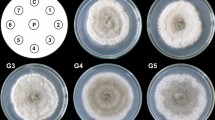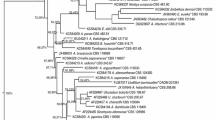Abstract
The proposed method includes primary and secondary treatments. Of the various disinfectants tested, 1-propanol and 1-butanol as a primary treatment and phenol, resorcinol, HgCl2 or NaCl as a secondary treatment completely eliminated the contamination hazard. 1-Butanol and phenol were not useful disinfectants since they inhibited the growth ofC. fusiformis along with the other contaminants. Primary and secondary treatment of sclerotia with 1-propanol and resorcinol, respectively, produced the maximum of stable cultures. Out of 120 cultures tested, 5 cultures demonstrated an appreciable yield of alkaloids under submerged cultural conditions.
Similar content being viewed by others
References
Amici A.M., Minghetti A., Scotti T., Spalla C., Tognoli L.: Production of ergotamine by a strain ofClaviceps purpurea (Fr.) Tul.Experientia22, 415 (1966).
Amici A.M., Minghetti A., Scotti T., Spalla C., Tognoli L.: Heterokaryosis and alkaloid production inClaviceps purpurea.Appl. Microbiol.15, 611 (1967).
Arcamone F.: TheClaviceps fermentation and the development of new ergoline drugs, p. 49 inD.A. Hems (Ed.):Biologically Active Substances: Exploration and Exploitation. John Wiley & Sons, New York 1977.
Arcamone F., Chain E.B., Ferretti A., Minghetti A., Pennella P., Tonolo A., Vero L.: Production of a new lysergic acid derivative in submerged culture by a strain ofClaviceps paspali.Proc. Roy. Soc. London, Ser. B155, 26 (1961).
Banks G.T., Mantle P.G., Szczyrbak C.A.: Large-scale production of clavine alkaloids byClaviceps fusiformis.J.Gen. Microbiol.82, 345(1974).
Gröger D., Tyler V.E., Jr.: Alkaloid production byClaviceps paspali in submerged culture.Lloydia26, 174 (1963).
Hoffmann A.:Die Mutterkorn Alkaloide (F. Enke, Ed.). Stuttgart 1964.
Mantle P.G.: Production of ergot alkaloids in vitro bySphacelia sorghi.J. Gen. Micribiol.75, 275 (1973).
Mantle P.G.: Industrial exploitation of ergot, p. 281 inJ.E. Smith, D.R. Berry (Eds):The Filamentous Fungi, Indistrial Mycology, Vol. 1. Edward Arnold, London 1975.
Řeháček Z.: Ergot alkaloids and some ptoblems of the physiology of their formation.Zentralbl. Bakteriol. Parasitenkd. Infectionskr. Hyg. Abt.129, 20 (1974).
Řeháčrk Z., Desai J.D., Sajdl P., Pažoutová S.: The cellular role of nitrogen in the biosynthesis of alkaloids by submerged culture ofClaviceps purpurea (Fr.) Tul.Can. J. Microbiol.23, 596 (1977).
Řičicová A., Řeháček Z.: Preparation of inoculum from sclerotia of the ascomyceteClaviceps purpurea.Folia Microbiol.13, 156 (1968).
Vining L.C., Nair P.M.: Clavine alkaloid formation in submerged cultures ofClaviceps species.Can. J. Microbiol.12, 915 (1966).
Author information
Authors and Affiliations
Rights and permissions
About this article
Cite this article
Desai, J.D., Desai, A.J. & Vaidya, H.C. A new method for isolation of saprophytic cultures ofClaviceps fusiformis from sclerotia. Folia Microbiol 27, 182–185 (1982). https://doi.org/10.1007/BF02877398
Received:
Issue Date:
DOI: https://doi.org/10.1007/BF02877398




